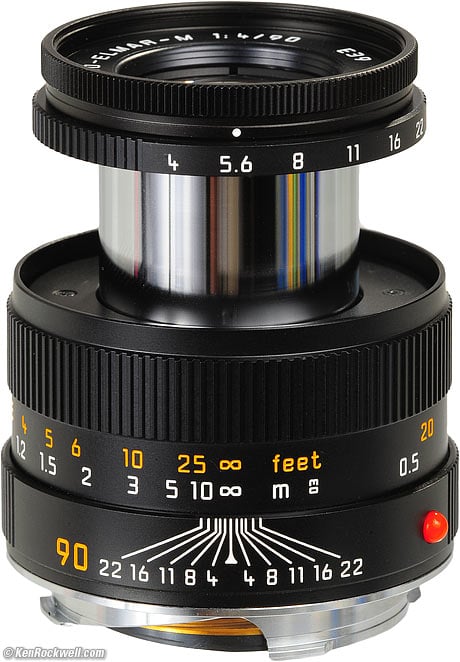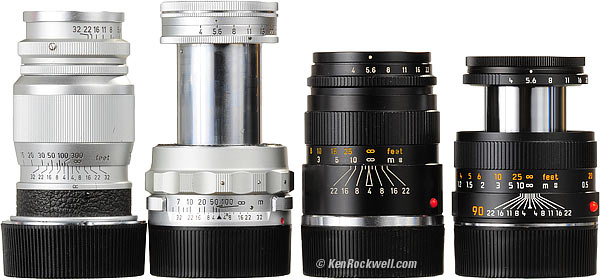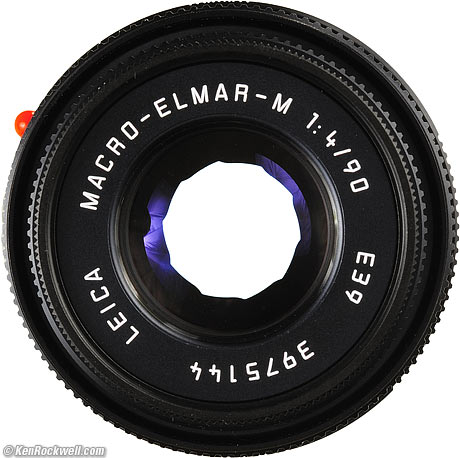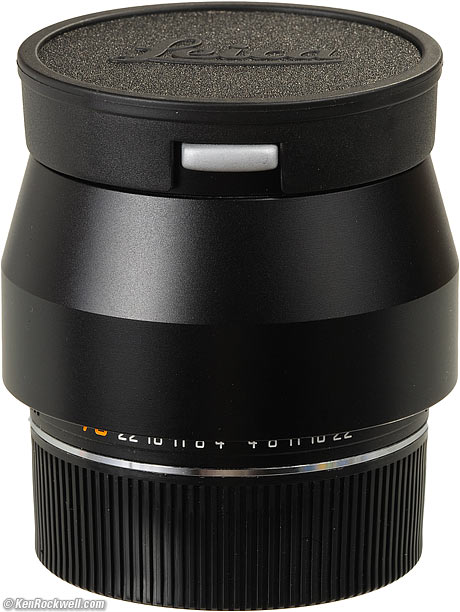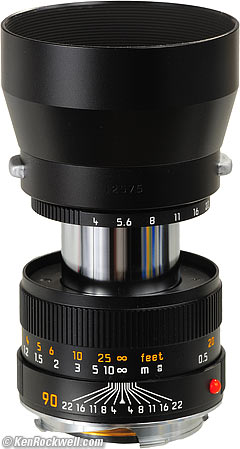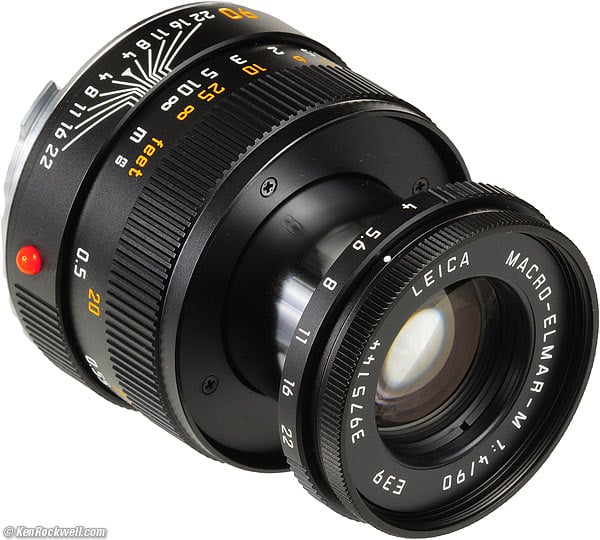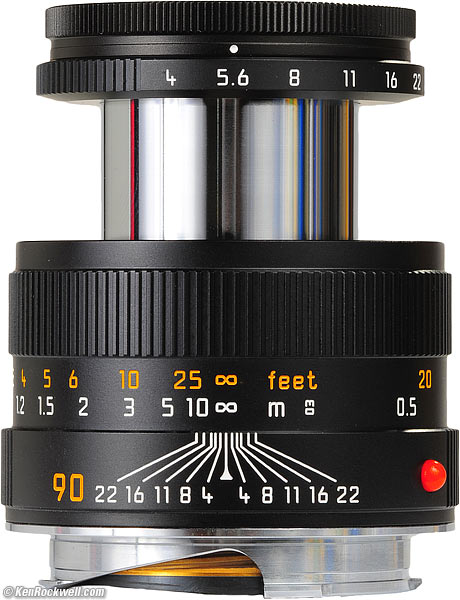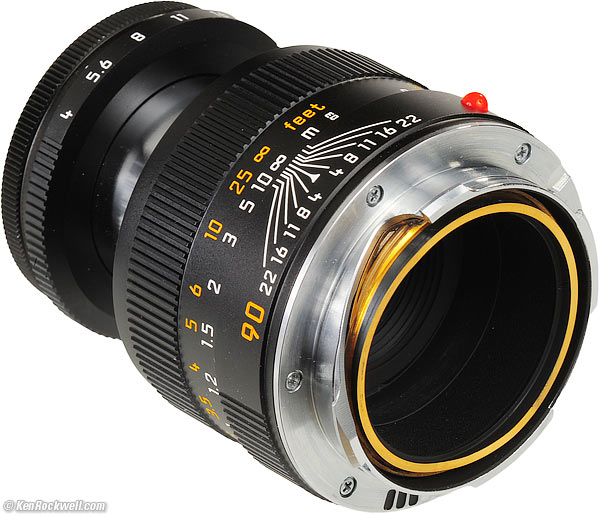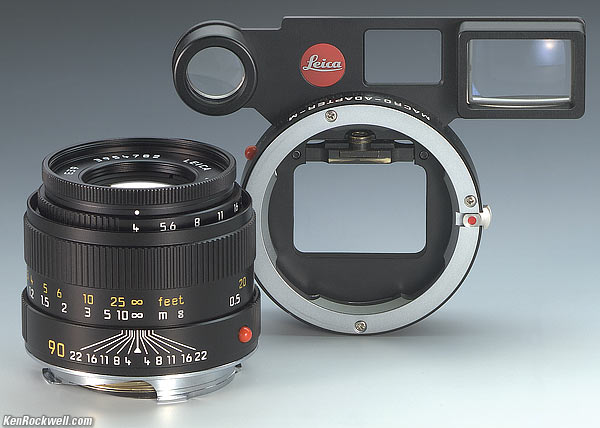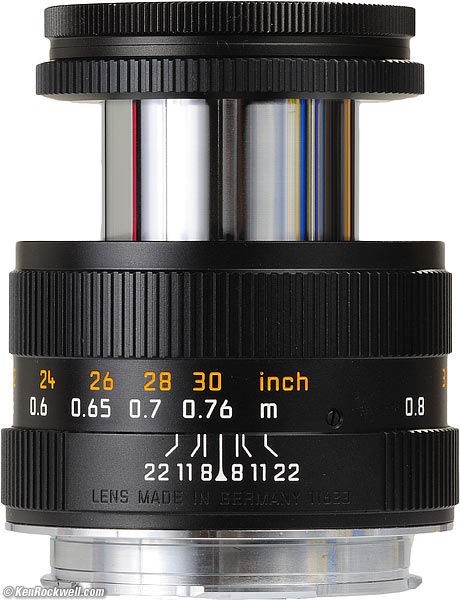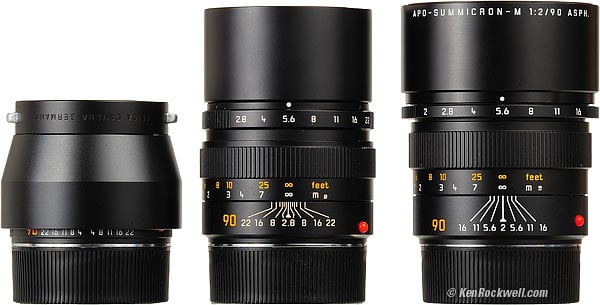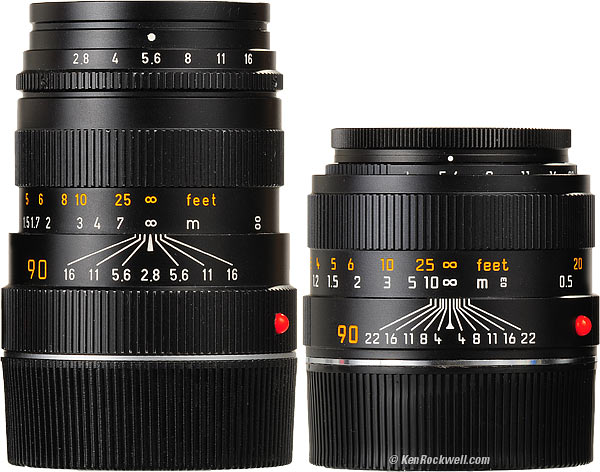Home Donate New Search Gallery Reviews How-To Books Links Workshops About Contact
LEICA 90mm f/4
MACRO-ELMAR-M
(2003-)
© 2013 KenRockwell.com. This page best with Corporate S regular and bold activated.
How to Shoot Macro Best Macro Lenses Compared
Intro Specs Performance Usage Compared Recommendations
LEICA MACRO-ELMAR-M 90mm f/4 (39mm filters, 7.8 oz./223g, about $4,000 with adapter). Vergrößern. I'd get it new at Adorama or used at eBay (see How to Win at eBay). This free website's biggest source of support is when you use those or any of these links when you get anything, regardless of the country in which you live — but I receive nothing for my efforts if you buy elsewhere. I'm not NPR; I get no government hand-outs and run no pledge drives to support my research, so please always use any of these links for the best prices and service whenever you get anything. Thanks for helping me help you! Ken.
June 2013 LEICA Reviews LEICA Lenses All Reviews
Leica 90mm f/2.8 Lenses Compared
Leica 90mm f/2 Lenses Compared
Sample Images from California's Gold Country April 2010
Introduction top
Intro Specs Performance Usage Compared Recommendations
This tiny LEICA MACRO-ELMAR-M 90mm f/4 is LEICA's biggest secret.
It's LEICA's smallest and lightest 90mm bayonet-mount lens ever made, and it also is among LEICA's very highest-performance 90mm lenses of all time.
It is an extraordinary 90mm tele lens for general use, and also focuses directly into the macro range with no fiddling or adapters required. It fits in a small pocket, and is the only 90mm you might ever need for anything.
LEICA keeps it hidden away from the other 90mm lenses by calling it "Macro" and hiding it at the bottom of their lens page, in the hope that people instead will buy the more expensive APO-SUMMICRON-M 90mm f/2 ASPH.
All by itself, this lens focuses from infinity to a super-close 0.78m (2.5 feet) in just 120º of focus-ring rotation. This is closer than any of Nikon's regular 85mm SLR lenses, for instance.
As an additional treat, this LEICA MACRO-ELMAR-M collapses for easy carrying.
If you buy the optional close-focus adapter 14 409, it provides a second even closer-focusing range from 0.5 ~ 0.76 m (20 ~ 30"). I'd pass on this adapter; if you're willing to go to the trouble of removing the lens and then attaching this adapter between the lens and camera, you'd be far better off with a Nikon SLR, like the Nikon FE, and any Nikon MICRO-NIKKOR lens, like any 105mm MICRO-NIKKOR, which will focus directly from infinity to at least half life-size in one range, all with far more accurate framing.
The only reason to endure the larger size and weight of the similarly classed LEICA 90mm f/2.8 ELMARIT-M or LEICA 90mm f/2 APO-SUMMICRON-M ASPH, or the low-priced LEICA 90mm f/2.5 SUMMARIT-M, is to gain a stop or two more speed. Otherwise, the optics are similarly spectacular among all these recent LEICA 90mm lenses, while this 90mm MACRO-ELMAR-M is significantly smaller, lighter, easier to focus and focuses more closely.
It sells for $2,000 new, or $3,800 with the close-focus adapter. and angle finder. Considering that the close-focus adapter sells for $1,100, and the angle finder for $300, separately, I'm unsure why the kit costs $3,800.
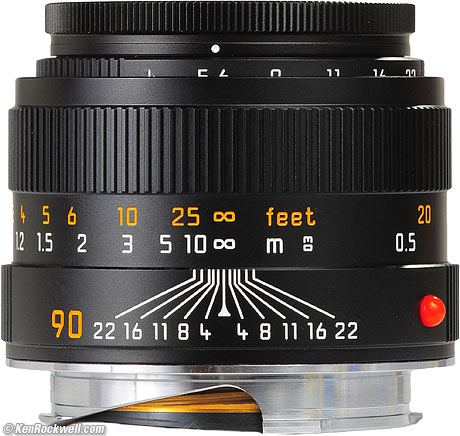
MACRO-ELMAR-M, collapsed.
Compatibility top
The LEICA 90mm f/4 MACRO-ELMAR-M works perfectly on every LEICA M camera, from the M3 of 1954, Minolta's CLE, and of course today's LEICA M7, LEICA MP and LEICA M9.
LEICA 90mm f/4 Bloodline top
ELMAR, ELMAR collapsible, ELMAR-C, MACRO-ELMAR-M. Vergrößern.
1933-1964: LEITZ ELMAR
This tiny lens came out in 1933 for screw-mount cameras. I'm showing the newest cosmetic variation on the left; earlier versions used different barrel designs.
A collapsible version, using the same optics, came out in 1954 for bayonet mount, as well as a fixed M-mount version.
Both were discontinued in 1964 from lack of interest; people chose the 90mm f/2.8 ELMARIT (1958-1974) instead.
1973-1978: LEITZ ELMAR-C top
The LEITZ ELMAR-C 90mm f/4 was introduced for the compact LEICA CL. It is 100% compatible with every LEICA M camera, especially the M9.
It was only made for a few years.
2003- : LEICA MACRO-ELMAR-M
Today's newest MACRO-ELMAR-M has optical performance far beyond any of the earlier 90mm lenses of any speed.
It's also the smallest and closest-focusing 90mm ever offered by LEICA, and the lightest bayonet-mount 90mm ever made.
Specifications top
Intro Specs Performance Usage Compared Recommendations
Name
Leica calls this the LEICA MACRO-ELMAR-M 90mm f/4.
Optics top

Cross-section.
4 elements in 4 groups.
Telephoto design: its physical length is shorter than its focal length, and the exit pupil is about 57% the diameter of the entrance pupil.
Single-coated, mostly in blue and amber.
The actual focal length for each sample is coded with two digits rotated 90,º between the FEET and M markings on the focus ring. The digits are the millimeters and tenths, thus this sample, marked "03," has an actual focal length of 90.3mm.
Diaphragm top
LEICA MACRO-ELMAR-M 90mm f/4 at f/5.6. Vergrößern.
10 blades.
Stops down to f/22.
Half-stop clicks.
The diaphragm has straight edges from f/4.7 ~ f/5.6 and from f/16 ~ f/19.
It has inwardly-curved edges from f/6.7 ~ f/13.
It is perfectly round at f/22.
Close Focus
Lens alone: 0.78 meters (2.5 feet), measured.
With close-focus adapter 14 409: focus range 0.5 ~ 0.76 meters (20 ~ 30"), marked.
Maximum Reproduction Ratio
Lens alone: 1:6.7.
With close-focus adapter 14 409: 1:3.
Size top
51.91mm diameter, maximum.
Extended: 59.37mm (2.337") extension from flange, 65.76mm (2.589") overall.
Collapsed: 40.67mm (1.601") extension from flange, 47.44mm (1.868") overall.
Filters
39 x 0.5mm screw-in filters (E39).
Attachments
LEICA-standard A42 slip-over and clip-on (42mm outside diameter).
This takes the same clip-on hoods as most other LEICA lenses since the 1950s.
Weight top
Lens alone: 7.850 oz. (222.6g), measured.
Hood: 0.920 oz. (26.1g), measured.
Lens and hood: 8.772 oz. (248.65g), measured.
Capped LEICA MACRO-ELMAR-M 90mm f/4 with hood. Vergrößern.
Carry weight (lens, hood and caps): 9.325 oz. (264.3g), measured.
Rated: 8.5 oz. (240g), black anodized aluminum; 11.3 oz. (320g), chromed-brass version.
Hood top
LEICA MACRO-ELMAR-M mit 12 575 hood, actual size. Vergrößern.
This lens take the same clip-on reversible 12 575 metal hoods as every other LEICA 90mm f/4 and f/2.8 and 135mm f/4.5 and 135mm f/4 lens since the 1950s. Even the part number is the same today as it was in the 1970s.
I'm sure that the earlier 1950s IUFOO hood works equally well.
Oddly, comparing today's 12 575 with a classic one (engraved in white with the compatible lenses), the classic hood is one millimeter longer, and otherwise the same shape. The classic has a little bit of black fuzz flocking, while the current one is all-ribbed metal inside.
Caps top
Front cap
Without the hood, the classic chromed-brass 14 122 pushes-on over the front of the lens, even with a filter attached. Today's replacement is the snap-on plastic E39 14 038.
To fit over reversed 12 575 hood, the 14 033 cap is included.
Rear cap
Today's standard 14 269 rear cap.
Part Numbers top
Lens
Black anodized aluminum
11 633 (shown here, $2,000).
As a kit with close-focus adapter 14 409: 11 629 ($3,800).
Chromed-brass
11 634 ($2,000).
As a kit with close-focus adapter 14 409: 11 639 ($3,800).
Cap for front of lens (no hood)
Classic 14 122 A42 push-on, or today's 14 038.
Hood
Cap to fit over reversed 12 575 hood
14 033.
Rear Cap
Standard 14 269 rear cap.
Close-focus adapter
14 409 ($1,100).
Angle Viewfinder
12 531 (About $300).
Included top
The standard lens comes with a leather case, 12 575 hood, 14 033 front cap and 14 269 rear cap.
The kit with 14 409 close-focus adapter adds the adapter and the 12 531 angle finder to the above.
Since the adapter sells separately for $1,100 and the angle finder sells for about $300, I have no idea why the kit with the adapter and angle finder costs an additional $1,800. Such is LEICA.
Quality top
Made in Germany.
LEICA LEITZ MACRO-ELMAR-M 90mm f/4. Vergrößern.
Performance top
Intro Specs Performance Usage Compared Recommendations
Bokeh top
Bokeh, the quality of out-of-focus areas as opposed to the degree of defocus, is wonderful wide-open. Backgrounds never distract. Bokeh degrades as stopped-down, but so what; if you need great bokeh, you're shooting wide-open anyway.
f/4: Wonderful. Blur circle edges are very soft.
f/5.6: Wonderful. Blur circle edges are very soft.
f/8: Neutral to excellent. Blur circles have soft edges.
f/11: Neutral to excellent.
Here are crops from extremely enlarged prints of about 36 x 48" (100 x 150cm), or the equivalent of looking at LEICA M9 images at 100% on-screen.
In these examples, the lens was focused at 3 meters (10 feet) and the synthetic reference vegetation seen out of focus in the background was at 15 meters (50 feet).
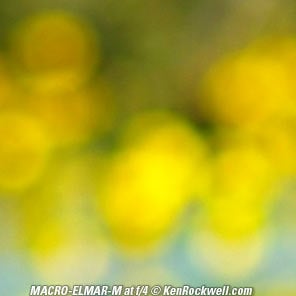 |
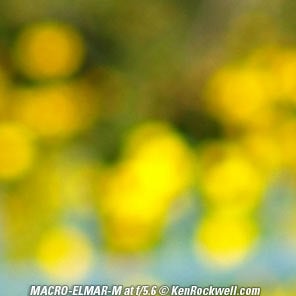 |
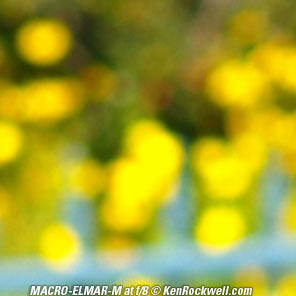 |
 |
Diaphragm Calibration top
The calibration is perfect.
The meter in my M9 tracks each half-stop click perfectly, except of course full aperture.
Distortion top
The LEICA MACRO-ELMAR-M 90mm f/4 has minor pincushion distortion. You won't see it unless you're looking for it, and even if you do, it's minor. This is due to its telephoto design; every other LEICA 90mm lens not marked "TELE" is a conventional long-focus design, with less distortion.
For critical photogrammetric use, use a value of -0.4 in Photoshop's lens distortion filter at 3 meters (10 feet), and -0.5 at infinity. I haven't tested for closer distances.
This is better than the LEICA 90mm f/2.8 TELE-ELMARIT-M (1974-1990), and about the same as the LEICA 90mm f/2.8 ELMARIT-M (1990-2008).
Ergonomics top
LEICA MACRO-ELMAR-M 90mm f/4. Vergrößern.
The LEICA MACRO-ELMAR-M 90mm f/4 handles great.
It's easy to focus and to adjust the aperture, with or without the hood attached.
Focus is fast and always accurate (for me, anyway); it turns from infinity to 0.78 meters in 120º.
I haven't tried the close-focus adapter 14 409, which is probably a pain.
Finder Blockage top
There is no blockage at any distance without the hood.
With the 12 575 hood, there is negligible blockage at infinity, increasing to moderate blockage at 0.78 meters.
Focus top
Focus accuracy is a personal issue between your sample of body and your sample of lens.
This said, this particular sample was perfect on my M9, much better actually than the 90mm f/2 APO ASPH I've used, meaning that for practical purposes, this MACRO-ELMAR-M gives much sharper results on my M9 because it's in better focus!
Falloff (darker corners) top
The LEICA 90mm f/4 MACRO-ELMAR-M has minor falloff at f/4, and none by f/5.6.
I've greatly emphasized it below by shooting a gray field and presenting it against another gray field.
LEICA MACRO-ELMAR-M 90mm f/4 falloff on M9 at infinity,
© 2010 KenRockwell.com. All rights reserved.
|
Lateral Color Fringes top
Surprisingly, there is a tiny amount (a fraction of a pixel) of magenta/green lateral color on an M9.
I doubt I could see it on film, it would be lost in the grain.
I wouldn't worry about it; it's only visible at 100% or greater looking specifically for it on M9 images, presuming you've shot something so boring that the sides are still in focus.
If it bothers you, which I doubt (it doesn't bother me), lug around the LEICA 90mm f/2.8 ELMARIT-M, LEICA 90mm f/2 APO-SUMMICRON-M ASPH, or the low-priced LEICA 90mm f/2.5 SUMMARIT-M instead.
Materials and Construction top
This MACRO-ELMAR-M is made the same as LEICA's other current lenses. It's all aluminum and brass. The only plastic is the red mounting index ball.
If you opt for the chrome version, it's all brass and weighs much more.All the marking are engraved.
Rear, LEICA MACRO-ELMAR-M 90mm f/4. Vergrößern.
Sharpness top
The more you know about photography, the more you know that lens sharpness doesn't matter.
This said, the LEICA MACRO-ELMAR-M is scaldingly sharp.
This lens is as good as the other newest LEICA 90mm f/2.8 ELMARIT-M, LEICA 90mm f/2 APO-SUMMICRON-M ASPH and LEICA 90mm f/2.5 SUMMARIT-M.
Leica has learned a lot over the decades in how to make a fantastic 90mm f/4 lens with only four pieces of glass. It's not 1933 any more.
When I went to the test range and shot the latest f/2.8 ELMARIT-M and f/2 APO-SUMMICRON-M ASPH against this tiny MACRO-ELMAR-M, the results are the same.
At the test range, this MACRO-ELMAR-M looks a tiny bit less sharp on the sides of LEICA M9 images seen at 100%, but this isn't significant. They're all too close to worry about slight differences visible only under direct test-range comparison; with LEICA, we select lenses based on size, weight and maximum aperture.
By comparison, when I compared this MACRO-ELMAR-M to any of the older f/4 or f/2.8 90mm lenses at the outdoor test range, they looked broken by comparison! The older lenses are softer in the center, and downright blurry on the sides compared to this MACRO-ELMAR-M.
This is a very, very sharp lens at every aperture. It's just as sharp wide open; in fact, I find f/4 to be the sharpest aperture; diffraction starts to dull things by f/5.6!
Usage top
Intro Specs Performance Usage Compared Recommendations
Erection
Pull the lens forward, and lock it with a short turn clockwise.
It locks in any of four positions at 90º spacing. Only the reason for the four positions is so you can put aperture scale where you'd like it for easiest reading.
Be sure to use a position in which you can read the aperture scale; unlike the original collapsible 90mm f/4 ELMAR, this newest MACRO-ELMAR-M has only one aperture scale.
Rotate the other way to collapse.
Achtung: Unlike the original collapsible 90mm ELMAR, there is no focus-ring lockout in the collapsed position. You easily could shoot all day in the collapsed position, wasting all your images. Be careful!
Caps
Hint: if you forgo using the hood and if you use a classic felt-lined chromed-brass push-on cap, it holds with just the right friction to let you erect or collapse the lens, all in one motion.
To erect and uncap in one motion, pull out the cap and the lens comes with it. Rotate the cap to lock the lens, and finish pulling off the cap.
To collapse and recap in one motion, push-on the cap, rotate to unlock, and push the rest of the way in.
Framing
Your LEICA will vary, but most of them are designed to give a loose frame at infinity and exact framing at 1 meter.
Since this lens focuses to only 0.8 meters all by itself, be sure to leave a little extra room so you don't lose anything. I find I can lose a bit off the top when I'm very close.
Close-Focus Adapter top
Lens with close-focus adapter 14 409. Vergrößern.
To focus more closely than 0.77m, attach the 14 409 adapter between camera and lens.
When you do, the clever Germans designed this system so that the lens mounts upside-down, and you now see this second set of focus and depth-of-field scales on its bottom:
Bottom, LEICA MACRO-ELMAR-M 90mm f/4. Vergrößern.
This second set of scales covers the focus distance from 0.5m to 0.76m.
The depth-of-field scale skipped f/16 and f/4 so that the digits could be scooted up to fit the engraved "LENS MADE IN GERMANY 11633" under it.
The eyes of the 50mm SUMMICRON with near-focusing range are much easier to use in the field, since you never need to remove the lens from the camera, but this MACRO-ELMAR-M gives tighter framing in one range (1:6.7) without its adapter than the 50mm SUMMICRON does at its closest setting with its auxiliary optics (1:7.something).
Use on the M3 top
Without the macro adapter, the M3 only focuses to 1 meter. You have to guess or measure the distance and set it on the lens' focus scale at closer distances.
I’m unsure if the macro adapter works on (attaches to) the M3; I haven’t tried it. Seeing how the 50mm SUMMICRON with Near-Focussing Range works best on the M3; I’ll gamble that the macro adapter probably works on the M3.
One catch: The M3 has the most accurate and precise focus of any and all M cameras. In doing that, it only focuses to 1 meter, not 0.7 meters as the newer, lesser cameras do. Therefore the macro adapter will likewise not couple to the M3s rangefinder at the closer end of its focus range.
It's silly trying to shoot macro with a rangefinder camera. This is one of many reasons LEICAs went obsolete in the 1960s when good SLRs came out.
Compared top
Intro Specs Performance Usage Compared Recommendations
See also Best Macro Lenses Compared.
Compared to current 90mm lenses
This MACRO-ELMAR-M, ELMARIT-M and APO-SUMMICRON-M. Vergrößern.
See also Leica 90mm f/2.8 Lenses Compared and Leica 90mm f/2 Lenses Compared.
MACRO-ELMAR-M |
||||
| Anno | 2003 - |
2008 - |
1990-2008 |
1998 - |
| Filter | 39mm |
46mm |
46mm |
55mm |
| f/max | f/4 |
f/2.5 |
f/2.8 |
f/2 |
| f/min | f/22 |
f/16 |
f/22 |
f/16 |
| Hood | screwy |
built-in |
built-in |
|
| Front attachments | A42 |
screwy |
none |
none |
| Focus Speed | Fast |
Fast |
Normal |
Normal |
| Weight | 223g |
344g |
395g |
473g |
| Distortion, ∞ | -0.5 |
-0.25 |
-0.5 |
-0.25 |
| Sharpness | Excellent |
Excellent |
Excellent |
Excellent |
| Mechanics | Excellent |
Weak |
Excellent |
Excellent |
| Price, 4/2010 | $2,000 ($700 used) |
Compared to classic 90mm f/4 lenses top
ELMAR, ELMAR collapsible, ELMAR-C, MACRO-ELMAR-M. Vergrößern
Specification Tables, 90mm f/4 lenses
ELMAR |
ELMAR Collapsible |
ELMAR-C |
MACRO-ELMAR-M |
|
| Anno | 1933-1964 |
1954-1964 |
1973-1978 |
2003 - |
| Collapsible? | No |
Yes |
No |
Yes |
| Filter | A36 |
39mm |
39x0.75mm |
39mm |
| f/max | f/4 |
f/4 |
f/4 |
f/4 |
| f/min | f/32 |
f/32 |
f/22 |
f/22 |
| Hood | rubber screw-on |
|||
| Front attachments | A36 |
A42 |
A42 |
A42 |
| Focus Speed | Normal |
Very Precise |
Normal |
Fast |
| Weight | 194g | 337g |
246g |
223g |
| Distortion, ∞ | -0.5 |
|||
| Sharpness | Good enough |
Good enough |
Good |
Excellent |
| Price, 4/2010 | $150 used |
$500 used |
$150 used |
Compared to f/2.8 TELE-ELMARIT-M top
f/2.8 TELE-ELMARIT-M and f/4 MACRO-ELMAR-M. Vergrößern
Even when extended, the MACRO-ELMAR-M is still a little bit shorter than the TELE-ELMARIT-M.
MACRO-ELMAR-M |
||
| Anno | 1974-1990 |
2003 - |
| Filter | 39mm |
39mm |
| f/max | f/2.8 |
f/4 |
| f/min | f/16 |
f/22 |
| Hood | ||
| Front attachments | A42 |
A42 |
| Focus Speed | Fast |
Fast |
| Weight | 225.6g |
222.6g |
| Distortion, ∞ | -1.0 |
-0.5 |
| Sharpness | Very Good |
Excellent |
| Price, 4/2010 | $500 used |
Recommendations top
Intro Specs Performance Usage Compared Recommendations
For the LEICA man, this is LEICA's very best lens for travel and light weight, which is the whole point of the LEICA. This is also LEICA's newest real 90mm lens. (The newer SUMMARIT-M is a bargain lens with excellent optics, but sub-LEICA-standard mechanics.)
For the critical user, this MACRO-ELMAR-M is the optical equal of the LEICA 90mm f/2.8 ELMARIT-M, LEICA 90mm f/2 APO-SUMMICRON-M ASPH or the low-priced LEICA 90mm f/2.5 SUMMARIT-M. The advantages of this tiny lens are its size, standard 39mm filters and hoods, and extra-close focusing without needing any adapters. If you don't shoot at f/2.8 or f/2, this MACRO-ELMAR-M is the lens to get.
If you're on a budget, which is never a good idea for lenses, the older f/2.8 TELE-ELMARIT-M is only 3 grams heavier, not that much longer and sells used for much less money, however its optics aren't as specular. For most users, the TELE-ELMARIT-M is more than good enough if price and weight matter.
Overall, I'm surprised this lens is so well hidden. By calling it "Macro" and confusing us with the dorky close-focus adapter, LEICA has kept this fantastic lens a secret.
If you get yours, or anything, at these links to them at B&H, Adorama and eBay, or locally in Southern California from OC Camera, It helps me keep reviewing these unusual items. Ken.
Deployment top
For use with color transparency film outdoors, I prefer a 39mm B+W 81A filter.
For B&W outdoors, you want a yellow filter standard, like the B+W 39mm #022, or a B+W 39mm orange filter for more contrast, especially in the skies.
For color print film or digital, you want a Leica 39mm silver-ring UV filter for protection, or go commando.
(the old M8 needed a Leica 39mm silver-ring IR filter.)
More Information top
Acknowledgements top
Many thanks to OC Camera for helping to get me access to this lens for review.
Help me help you top
I support my growing family through this website, as crazy as it might seem.
The biggest help is when you use any of these links to Adorama, Amazon, eBay, Ritz, Calumet, J&R and ScanCafe when you get anything, regardless of the country in which you live. It costs you nothing, and is this site's, and thus my family's, biggest source of support. These places have the best prices and service, which is why I've used them since before this website existed. I recommend them all personally.
If you find this page as helpful as a book you might have had to buy or a workshop you may have had to take, feel free to help me continue helping everyone.
If you've gotten your gear through one of my links or helped otherwise, you're family. It's great people like you who allow me to keep adding to this site full-time. Thanks!
If you haven't helped yet, please do, and consider helping me with a gift of $5.00.
As this page is copyrighted and formally registered, it is unlawful to make copies, especially in the form of printouts for personal use. If you wish to make a printout for personal use, you are granted one-time permission only if you PayPal me $5.00 per printout or part thereof. Thank you!
Thanks for reading!
Mr. & Mrs. Ken Rockwell, Ryan and Katie.
Home Donate New Search Gallery Reviews How-To Books Links Workshops About Contact

